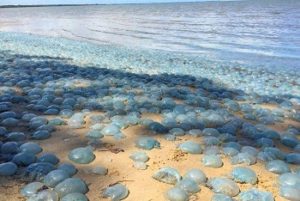
Creating an eye-popping sight for visitors and leaving them deceived by what lay in front of them, thousands of blue blubber jellyfish were found washed up and spread across the Deception Beach in Queensland, Australia.
Charlotte Lawson – who first photographed the jellyfish carpet – told the BBC that the sight of blue jellyfish on the beach looked like a tide having come in.
“When we got closer we realized it was jellyfish,” she said.
“It happens every year but there’s never been this many, this year it’s been heaps.”
“It was like bubble-wrap across the beach.”
A marine biologist Dr Lisa-Ann Gershwin described the sight as “a wallpaper of jellyfish” and the biggest she had seen in 25 years of research.
According to Dr Gershwin, stranding of jellyfish on the beach was part of a phenomenon called a “bloom”.
“Jellyfish bloom is part of their lifecycle and if the winds blow just right and if the water level falls with the tide, then they get stranded.”
“We see jellyfish bloom, but not like this, this is jaw-dropping. I’ve never seen them that close together.”
“They are just cheek by jowl. They are packed so tightly. It’s a sea of blue,” Gershwin told ABC News.
“I can’t imagine what they would look like in the water, for them to have stranded that close together.”
According to Gershwin, warmer waters, tide conditions and northerly winds would have caused these creatures to strand in such large numbers.
The blue blubber jellyfish is the most common jellyfish found in south-east Queensland. These marine creatures swim just below the surface of the water and are often found in dense swarms. Mass beachings of jellyfish around Queensland beaches have been witnessed in the past.
The creatures can grow to a diameter of 30-45 cm, and eat plankton, crustaceans and even small fish to survive. In Sydney waters, jellyfishes with creamy white or brown color are found, but farther north in Australia, usually blue colored jellyfishes are seen. The color comes from the pigment that is produced in the body. They have eight clublike oral arms, with each containing several mouths to transport food to the stomach. These creatures alternate between a sexual medusa stage and an asexual polyp stage. They are commercially harvested in Australia, thus posing a potential threat to their population. People eat them after correctly drying and processing. In China, it is believed that eating jellies can reduce high blood pressure.
Their sting is not dangerous for humans, although it might be painful. Wrapped ice or cold packs should be applied if one stings someone.
Over 22,800 swimmers were treated for stings by bluebottle jellyfishes on the Sunshine Coast from 1 December to 31 January, according to Surf Life Saving Queensland.
“We’ve had a prevalence of bluebottle jellyfish and other fire-type stingers on the Sunshine Coast,” Dr Capps told the BBC, while adding that he had treated three dogs for stings at his Sunshine Coast veterinary clinic at the weekend.
“Some dogs have been eating them and it’s a very painful experience for them,” he said.
